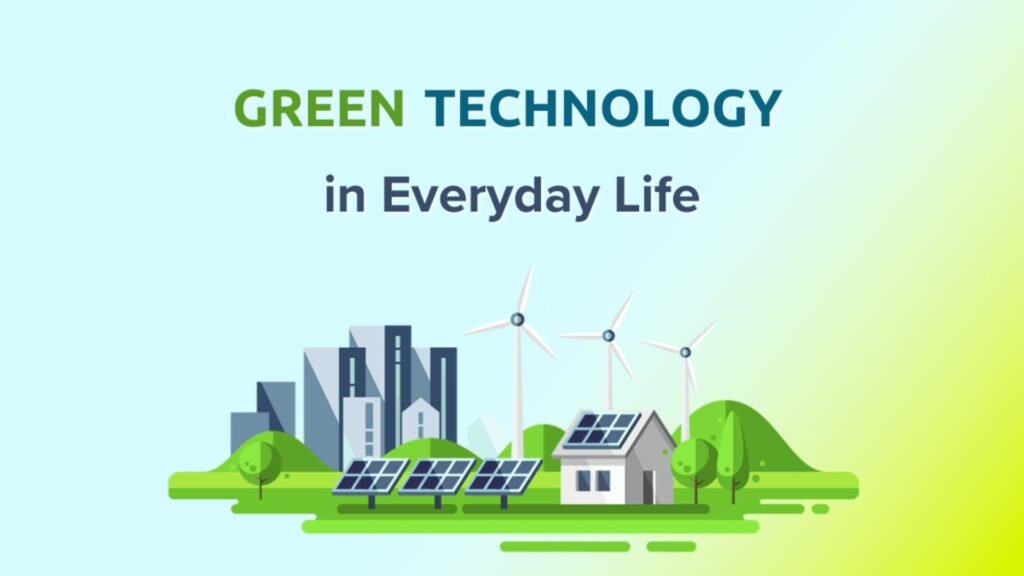Ways to Incorporate Green Technology in Your Life
Incorporating green technology into your daily life is an effective way to reduce your environmental footprint and promote sustainability. From energy-efficient appliances to eco-friendly transportation, green technology offers numerous solutions to help you live more sustainably. Here’s how you can Incorporate Green Technology in Your Life.

Energy-Efficient Appliances
Energy-efficient appliances reduce energy consumption and lower utility bills.
- LED Lighting: Replace traditional incandescent bulbs with LED lights, which use less energy and have a longer lifespan.
- Smart Thermostats: Install a smart thermostat to optimize heating and cooling based on your schedule, helping you save energy and reduce costs.
- Energy Star Appliances: Choose appliances with the Energy Star label, indicating they meet high energy efficiency standards.
Solar Power
Solar power is a renewable energy source that can be harnessed for various uses.
- Solar Panels: Install solar panels on your roof to generate electricity and reduce reliance on fossil fuels.
- Solar Water Heaters: Use solar water heaters to warm water for domestic use, reducing the need for electric or gas-powered water heaters.
- Solar Chargers: Utilize portable solar chargers to power small electronic devices while on the go.
Electric Vehicles
Electric vehicles (EVs) offer a cleaner alternative to traditional gasoline-powered cars.
- EVs: Invest in an electric vehicle to reduce greenhouse gas emissions and lower your carbon footprint.
- Home Charging Stations: Install a home charging station to conveniently charge your EV and take advantage of lower electricity rates.
- Public Charging Networks: Use public EV charging networks to keep your vehicle charged during long trips.
Smart Home Technology
Smart home technology helps manage energy use and promotes efficiency.
- Smart Plugs: Use smart plugs to control the power consumption of devices and appliances remotely, ensuring they are turned off when not in use.
- Smart Lighting: Install smart lighting systems that can be programmed to turn off when not needed and adjust brightness based on natural light.
- Home Automation: Implement home automation systems to optimize energy use and improve overall efficiency.
Water Conservation Technologies
Water conservation technologies help reduce water waste and improve efficiency.
- Low-Flow Fixtures: Install low-flow showerheads and faucets to reduce water consumption without sacrificing performance.
- Smart Irrigation Systems: Use smart irrigation systems that adjust watering schedules based on weather conditions and soil moisture levels.
- Water-Efficient Appliances: Choose dishwashers and washing machines designed to use less water while maintaining performance.
Green Building Materials
Green building materials contribute to environmentally friendly construction and renovation.
- Sustainable Flooring: Opt for flooring materials made from renewable resources, such as bamboo or cork.
- Recycled Materials: Use recycled or reclaimed materials for construction and renovation projects to minimize waste and reduce the demand for new resources.
- Insulation: Choose eco-friendly insulation materials, like cellulose or spray foam, to improve energy efficiency and reduce heating and cooling costs.
Eco-Friendly Consumer Products
Eco-friendly consumer products help reduce waste and promote sustainability.
- Reusable Items: Replace single-use items with reusable alternatives, such as water bottles, shopping bags, and coffee cups.
- Biodegradable Products: Choose biodegradable or compostable products to reduce the environmental impact of waste.
- Eco-Friendly Cleaning Supplies: Use cleaning products made from natural ingredients that are free from harmful chemicals and pollutants.
Green Energy Solutions
Green energy solutions focus on using renewable resources to generate power.
- Wind Turbines: Install a small-scale wind turbine if you live in a windy area to generate clean electricity for your home.
- Hydro Power: Explore options for micro-hydro power systems if you have access to a flowing water source.
- Renewable Energy Plans: Choose a green energy plan from your utility provider that sources electricity from renewable resources like wind or solar.
Sustainable Gardening
Sustainable gardening practices promote environmental health and efficiency.
- Organic Gardening: Use organic methods to grow plants, avoiding synthetic pesticides and fertilizers that can harm the environment.
- Rainwater Harvesting: Collect rainwater in barrels to water your garden, reducing the demand on municipal water supplies.
- Native Plants: Plant native species that require less water and maintenance, supporting local ecosystems and wildlife.
Eco-Friendly Technology Gadgets
Eco-friendly technology gadgets help reduce environmental impact and support sustainable living.
- Solar-Powered Gadgets: Use solar-powered chargers and devices to reduce reliance on conventional electricity.
- Energy-Efficient Electronics: Choose electronics with energy-saving features, such as power-saving modes and low standby consumption.
- Green Tech Startups: Support companies and startups that focus on developing innovative green technologies and solutions.
Conclusion
Incorporating green technology into your life is a practical way to support sustainability and reduce your environmental impact. From energy-efficient appliances and solar power to eco-friendly consumer products and sustainable gardening, there are many ways to embrace green technology and make a positive difference. By making conscious choices and adopting these technologies, you can contribute to a more sustainable future.



